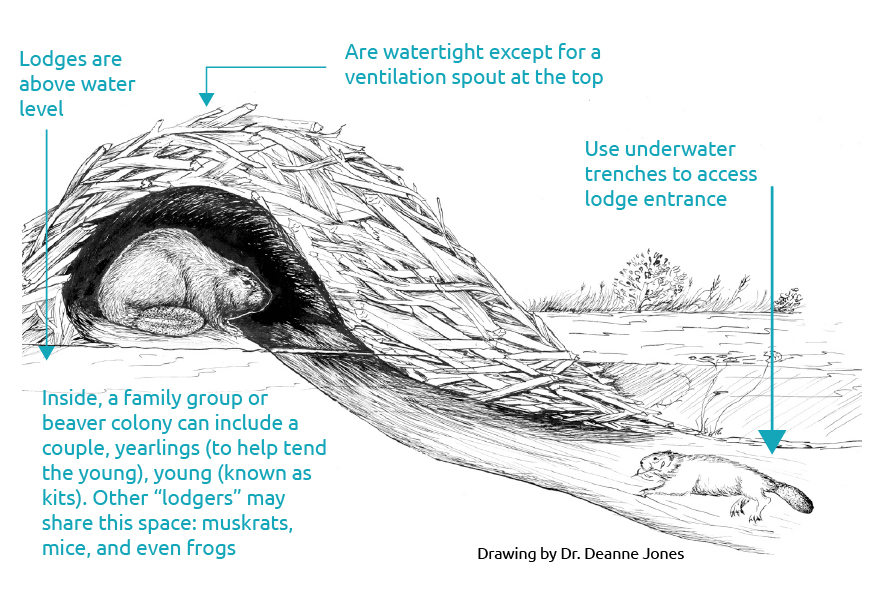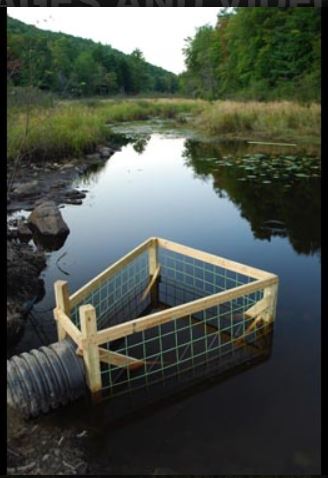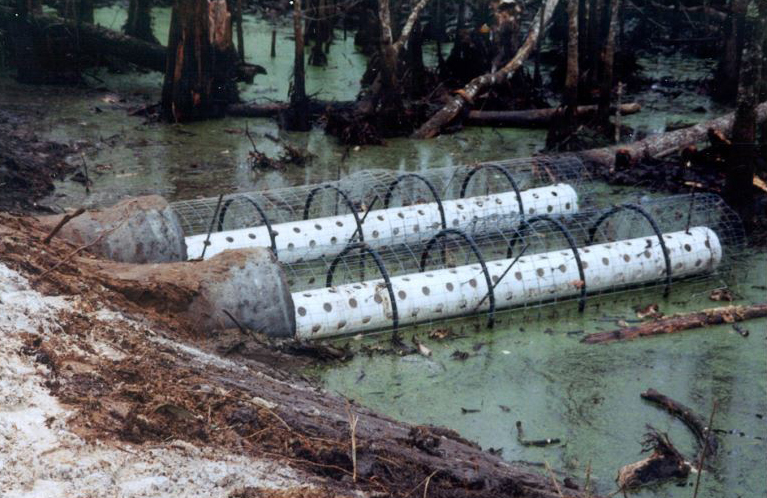Living with Beavers: How to Co-exist with Nature’s Eco Engineer
Written by Heather J. Marshall
An evolving relationship with a national emblem
By the early 1900s, beavers were nearly wiped out in Canada due to the fur trade. As beavers made a comeback in the 1920s and 1930s, their dams spread over the prairie landscape, often creating unwanted flooding for landowners and farmers. It’s a complicated relationship with our national emblem: We admire their industrious nature, but wish it wasn’t happening in our own backyard. But with water becoming one of our most precious resources, we are rethinking the beaver’s role as an “ecosystem engineer”, which could help sustain the water we need to survive.
About Beavers
Beavers are semi-aquatic rodents that are well adapted for life between land and water. Some of their adaptations are shown in the image below:
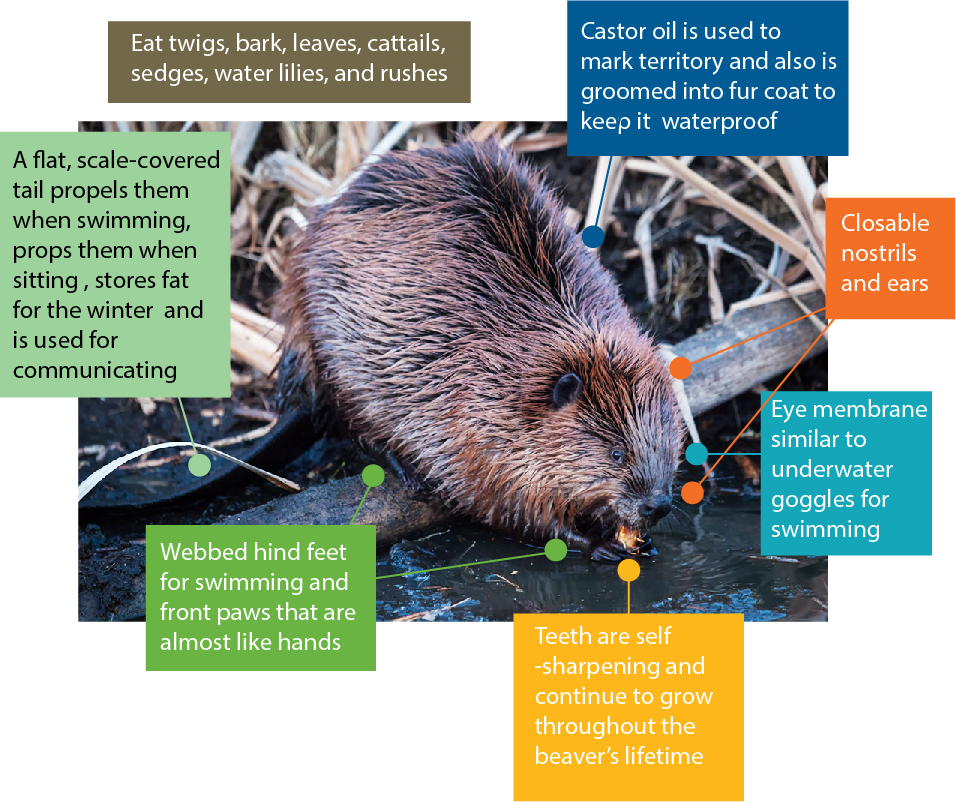
DID YOU KNOW? Not all trees types suffer from beaver activity. Research in Rocky Mountain National Park showed that willows grew better when cut by beavers and trembling aspen also recovered quite well.
Beaver Dams & Lodges
- Dams:
- Built where water is not moving too fast or it is inhibited
- Purpose is to surround their home or lodge with enough water to protect it from predators
- Lodges:
- Are generally the cone structures most associated with beavers
- Can be burrowed into a bank or cliff if water is moving faster
DID YOU KNOW? The world’s largest known beaver dam is found in Alberta’s Wood Buffalo National Park and measures 2,790 feet (850 m) in length.
Why Beavers are Important for the Prairies & Water
- Keystone species such as beaver fill a unique role in the ecosystem
- Beavers keep a diversity of plant species and wildlife present that thrive in slow-moving water
- As “Ecosystem engineers” beavers provide benefits such as
- Slowing water flow, which helps long-term flood resilience
- Maintaining water levels throughout the year
- Reducing soil erosion
- Moderating water temperature year-round, which benefits fish
- Trapping and storing sediment, contaminants, and nutrients, which means better water quality for fish and people
- Creating habitat that other wildlife use as a place to feed, nest or rest — even underwater in the winter
For more info about the Benefits of Beavers and their role in watershed function, go to Cows and Fish’s presentation “Beavers in Our Landscape: Ecology and Case Studies Webinar”.
Beaver Research in Central Alberta
In their research, University of Alberta professors, Drs. Glynnis Hood and Suzanne Bayley, looked at how the relationship between beavers and water on the landscape over a 50+ year period.
- As beavers came back to the prairies, the ponds with beaver’s present had 9 times more water in them than those without beavers
- They found that during the 2002 drought, the wetlands that had beaver in them continued to have higher water levels, so they sustain water on the landscape
- Beaver lodges alone accounted for 83% of open water on the landscape
- Further research showed that beaver channels not only connect ponds, but focus runoff into these channels
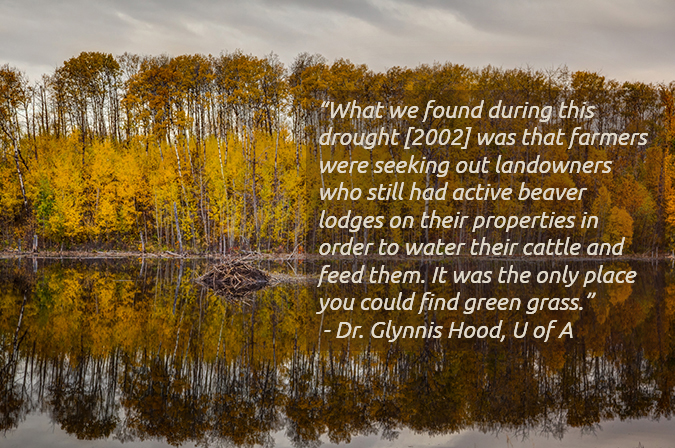
To learn more about this research and other interesting stories about what makes beavers an important species, please watch the PBS special: “Leave it to Beavers“.
DID YOU KNOW? The sound of running water is like music to beavers’ highly sensitive ears. It appears to trigger their instinct to start building. A conservation officer in Gatineau Park used recordings of running water to inspire beavers to build dams in areas where they were needed — and away from where they were causing unwanted flooding.
Solutions for Living with Beavers
Over time, ways of managing beavers have grown and evolved. Cows and Fish put together a tool for agricultural producers looking at options (ranging from traditional to newer methods) for managing beavers on their land. To get a free copy of the Beaver Management for Agricultural Producers Decision Matrix PDF, click here.
2 examples from what you’ll find inside the Matrix are shown below:
Remove Dam
-
- Advantages: lower water levels, reduced flooding and beavers may move elsewhere
- Disadvantages: Possible new dam development, without population change, removal of dam is often wasted effort
- Time and Cost: High for both
- Agricultural Effects: Temporary solution to flooding issues
- Ecological Effects: Downstream flooding, bank erosion, negative fish and wildlife impacts
- Management Effectiveness: Fair
- Solution over time: Short-term
Tree wrapping
-
- Advantages: Save key or specific tree groves
- Disadvantages: Labour intensive initially, doesn’t protect all sizes or types of trees/shrubs
- Time and Cost: Medium and Low
- Agricultural Effects: Shade trees available for humans and livestock
- Ecological Effects: Stream banks protected helps moderate water temperature and provide aquatic habitat
- Management Effectiveness: Good
- Solution over time: Long-term
Innovative Beaver Co-existence Tools
(*Please note that some of these tools or devices may require permits)
1. Barriers for Beaver Building: Culvert Fences or Guards such as the Beaver Deceiver
- Limited water movement lessens beavers desire to build a dam
- Installed upstream, to keep culvert entrance unblocked
Beaver Deceiver Image: How to Keep Beavers From Plugging Culverts, USDA
2 Water Regulators: Pond levelers such as the Beaver Baffler or Clemson Pond Leveler
- Maintains water levels
- Placed several metres upstream and under water, so that sound of running water is minimized
Clemson Pond Leveler: A perforated pipe is used for water intake and a flow reducer slows water before it exits on the other side of the culvert’s output pipe. Image: How to Keep Beavers From Plugging Culverts, USDA
Go to http://rockies.ca/beavers/landowners.php to find out more about management and co-existence tools
*Before Installing
To find out more about installing a culvert guard or a pond leveler, please call your local municipality, Cows and Fish, or ALUS. You may be able to apply for grant money to fund part of your project through the above organizations or through your local watershed organization.
You may have to get authorization under the Public Lands Act. This applies to most rivers and creeks, and some smaller watercourses and wetlands. https://www.alberta.ca/water-boundaries.aspx
You can either apply for temporary or permanent authorization for your project at the following: https://open.alberta.ca/publications/public-lands-formal-disposition-application-process
To learn more about some case studies where these methods have been used in Alberta and in the US, please watch Cows and Fish’s presentation “Beavers in Our Landscape: Ecology and Case Studies Webinar” or watch the PBS special: “Leave it to Beavers“.
Still not sure?
Check out this Cost-Benefit Analysis of Beaver Coexistence Tools

Heather J. Marshall is a freelance writer and graphic designer. Her main interests are local food and history, human connection to the environment, and biographical stories. To contact Heather, please go to: hmmcreate.myportfolio.com

